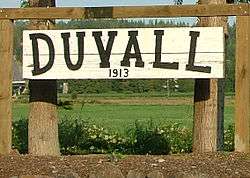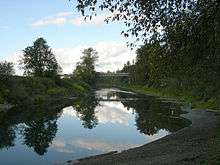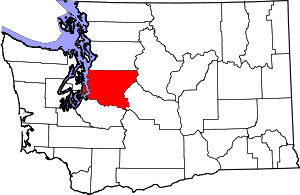Duvall, Washington
Duvall is a city in King County, Washington, United States, located on SR 203, halfway between Monroe and Carnation.[5] The population was 6,695 at the 2010 census and is estimated to be 8,061 as of 2018.
Duvall, Washington | |
|---|---|
 Duvall town sign | |
| Motto(s): Small Town. Real Life. | |
 Location of Duvall, Washington | |
| Coordinates: 47°44′3″N 121°58′32″W | |
| Country | United States |
| State | Washington |
| County | King |
| Area | |
| • Total | 2.47 sq mi (6.40 km2) |
| • Land | 2.45 sq mi (6.35 km2) |
| • Water | 0.02 sq mi (0.05 km2) |
| Elevation | 89 ft (27 m) |
| Population | |
| • Total | 6,695 |
| • Estimate (2019)[3] | 8,107 |
| • Density | 3,307.63/sq mi (1,277.25/km2) |
| Time zone | UTC-8 (Pacific (PST)) |
| • Summer (DST) | UTC-7 (PDT) |
| ZIP code | 98019 |
| Area code(s) | 425 844 |
| FIPS code | 53-19035 |
| GNIS feature ID | 1512165[4] |
| USDA Hardiness Zone | 8 |
| Website | duvallwa.gov |
| FIPS code and GNIS feature ID come from the U.S. Census Bureau and the U.S. Geological Survey. | |
History

The area that became known as Duvall was historically the home of the Snoqualmie and other ancestral Tulalip Native American tribes. Following their relocation under the Treaty of Point Elliott, the area was homesteaded by veterans of the Civil War.[6] The center of present-day town was located on a hillside homesteaded by Francis and James Duvall, loggers who arrived in 1871.[6]
An early milestone in the settlement of Duvall proper was the relocation of the town of Cherry Valley. Around 1909, the Chicago, Milwaukee and St. Paul Railroad agreed to move Cherry Valley homes and businesses to Duvall in order to continue the construction of a railroad line along the Snoqualmie River.[6] The newly relocated town, briefly named Cosgrove after Samuel G. Cosgrove, underwent a real estate boom; streets and sidewalks were laid and a train depot was constructed.[6] This was followed by construction of a movie house, a drug store, a new schoolhouse, and several hotels.[6] By 1911, the Duvall Citizen began publishing regular editions of news events.[6][7]
On April 28, 1968, nearly 3,000 fans attended a rock concert at a farm in Duvall where an upright piano was dropped from a helicopter. Performances included Country Joe and the Fish. This concert is well known to locals as the Piano Drop. This event inspired the Sky River Rock Festival which occurred later that year.[8]
The town of Duvall has experienced a great amount of construction during the period of 2008–2009 with the aim of making the one-road town center more accessible and presentable to tourists.[9]
Town events
Community Easter Egg Hunt held every year in McCormick Park, open to everyone.
The year's largest and most popular event is 'Duvall Days' which is held the first weekend in June in downtown Duvall, with other activities at nearby locations. Saturday events include a parade, street side vendors, live entertainment, and many games and activities for children. There is a car show called 'The Duvall Classic Car Show' held in the Duvall Safeway parking lot, and the 'Duvall Run' at McCormick Park with 10-kilometer and 5-kilometer races. 2017 and 2018 also included an evening fireworks display. On Sunday, the staff of Fire District 45 host their annual pancake breakfast at the downtown station.
SandBlast Festival of the Arts, third weekend in July.
Outdoor music in July at Summer Stage and Movies In The Park in August, all located in McCormick Park.
Duvall hosts an annual 'Tree Lighting' to begin the Christmas season.
Duvall also has a newer event called March of the Vegetables, a parade celebrating the vegetables and art of Duvall. The event is put on by people in the community.
Geography
Duvall is located at 47°44′3″N 121°58′32″W (47.734149, -121.975493).[10]
According to the United States Census Bureau, the city has a total area of 2.49 square miles (6.45 km2), of which, 2.47 square miles (6.40 km2) is land and 0.02 square miles (0.05 km2) is water.[11]
Climate
The climate in this area has mild differences between highs and lows, and there is adequate rainfall year-round. Because of its location relative to the Northern Cascades, the surrounding Snoqualmie Valley is subject to flooding from late fall to early spring. According to the Köppen Climate Classification system, Duvall has a marine west coast climate, abbreviated "Cfb" on climate maps.[12]
Demographics
| Historical population | |||
|---|---|---|---|
| Census | Pop. | %± | |
| 1920 | 258 | — | |
| 1930 | 200 | −22.5% | |
| 1940 | 234 | 17.0% | |
| 1950 | 236 | 0.9% | |
| 1960 | 345 | 46.2% | |
| 1970 | 607 | 75.9% | |
| 1980 | 729 | 20.1% | |
| 1990 | 2,770 | 280.0% | |
| 2000 | 4,616 | 66.6% | |
| 2010 | 6,695 | 45.0% | |
| Est. 2019 | 8,107 | [3] | 21.1% |
| U.S. Decennial Census[13] 2018 Estimate[14] | |||
2010 census
As of the census[2] of 2010, there were 6,695 people, 2,224 households, and 1,816 families residing in the city. The population density was 2,710.5 inhabitants per square mile (1,046.5/km2). There were 2,315 housing units at an average density of 937.2 per square mile (361.9/km2). The racial makeup of the city was 89.7% White, 0.4% African American, 0.5% Native American, 2.7% Asian, 2.9% from other races, and 3.8% from two or more races. Hispanic or Latino of any race were 7.7% of the population.
There were 2,224 households of which 52.3% had children under the age of 18 living with them, 70.2% were married couples living together, 8.0% had a female householder with no husband present, 3.4% had a male householder with no wife present, and 18.3% were non-families. 14.4% of all households were made up of individuals and 2.8% had someone living alone who was 65 years of age or older. The average household size was 2.99 and the average family size was 3.33.
The median age in the city was 34.4 years. 33.8% of residents were under the age of 18; 4.8% were between the ages of 18 and 24; 33.2% were from 25 to 44; 23.7% were from 45 to 64; and 4.5% were 65 years of age or older. The gender makeup of the city was 49.5% male and 50.5% female.
References
- "2019 U.S. Gazetteer Files". United States Census Bureau. Retrieved August 7, 2020.
- "U.S. Census website". United States Census Bureau. Retrieved December 19, 2012.
- "Population and Housing Unit Estimates". United States Census Bureau. May 24, 2020. Retrieved May 27, 2020.
- "Duvall". Geographic Names Information System. United States Geological Survey.
- About Duvall Archived 2010-05-27 at the Wayback Machine from the city's official website
- Duvall — Thumbnail History from the Online Encyclopedia of Washington State History
- Duvall Newspaper Index from the Online Encyclopedia of Washington State History
- Walt Crowley, Rites of Passage: A Memoir of the Sixties in Seattle (Seattle: University of Washington Press, 1995), 110-112, 255.
- "Duvall". Snoqualmie Valley Historical Museum. Snoqualmie Valley Historical Museum. Retrieved 13 June 2017.
- "US Gazetteer files: 2010, 2000, and 1990". United States Census Bureau. February 12, 2011. Retrieved April 23, 2011.
- "US Gazetteer files 2010". United States Census Bureau. Archived from the original on July 2, 2012. Retrieved December 19, 2012.
- Climate Summary for Duvall, Washington
- United States Census Bureau. "Census of Population and Housing". Retrieved July 9, 2013.
- "Population Estimates". United States Census Bureau. Retrieved June 21, 2019.
External links
| Wikimedia Commons has media related to Duvall, Washington. |
